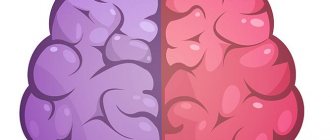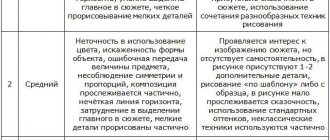Hello, friends! Lyudmila Redkina is in touch. When I was looking for a job for the first time, I often came across advertisements with the phrase “Requirements for a candidate: ..., creative, able to think critically, ...” In our 21st century, simple knowledge in any professional field is not surprising. There are tons of information: a lot of e-books, printed works on various topics. Now people with creativity and critical thinking, who could bring sparkle, innovation, and passion to the profession, are valued everywhere. In this article we will talk about what critical thinking is and what techniques can be used to improve it, and we will also look at whether the development of critical thinking contributes to the progress of society.
COMPLETE LIST OF HUMAN SKILLS
Critical thinking in psychology
Diane F. Halpern, a scientist from the USA, defines it as a type based on cognitive skills and the habit of thinking strategically and logically. She pays special attention to the fact that this is not an innate skill, and it is quite amenable to development.
Moreover, it needs to be developed. After all, a person who knows how to think critically is able to:
- be observant
- concentrate on the main thing,
- capture turning points and key moments,
- analyze the situation correctly,
- correctly justify your opinion,
- interpret correctly.
Professor, author of books on critical thinking, David Kluster, divides it into 5 types:
- independent,
- reasoned,
- generalized,
- social,
- evaluative.
Interesting read: Spatial Thinking
Kinds
In psychology, only one classification has been proposed.
Poor critical thinking
Belongs to a highly qualified pseudo-intellectual who has a selfish motivation, is exclusively occupied with his own good and does not think about the ethical consequences of his actions. Pursues selfish goals.
Strong critical thinking
It belongs to a person who strives to comprehend the logic of what is happening with good intentions, for the purpose of objective study. There is no egocentric bias. Direction to overcome obstacles on the path to truth.
How does this classification work in real life? Let's imagine a large holding company. The head of the financial analytics department, with poor critical thinking, discovered an unofficial flow of money going past the accounting department. He immediately analyzes the situation, calculates all the moves, finds a way to transfer this money to his personal account, without thinking about the company’s losses and the affected parties.
If in his place there is a person with strong critical thinking, he will analyze the situation in such a way as to legalize the discovered financial flow and use it for the development of the holding.
Development methods
Effective training for the development of critical thinking are online simulators that allow you to form and consolidate new skills.
How to train critical thinking online
The course lessons serve to develop the following skills:
- competent expression of thoughts,
- making effective decisions,
- ability to reason,
- ability to analyze.
These skills will be in demand if a non-standard practical task arises. When a problem arises in professional activity that cannot be solved with the help of existing knowledge and skills, the ability to think non-trivially can help.
Benefits of the course
Errors are human. Or more precisely, the brain. And these mistakes are well understood not only by researchers of mental activity, but also by those who want to sell their ideas or products. Propagandists and advertisers are well versed in the weaknesses of human thinking. Read more about these tricks in the article Neuroeconomics, the science that reads our thoughts and decisions
A critical mind will not allow your life to be manipulated and will keep you from wasting money, resources and time. Spend only 15 minutes a day on online training, develop the capabilities of your brain and achieve success in your career, study, and life.
What it is
Psychology gives the following encyclopedic definition: critical thinking is a person’s ability to comprehensively analyze things and events, interpret them and make reasonable assessments, followed by the formation of conclusions that allow them to be applied to various problem situations. There are other attempts to explain this term:
- correct assessment of statements;
- reflections on thinking;
- reflection, which ultimately allows you to decide what to trust and what to do with it all;
- a complex of intellectual processes - analysis, conceptualization, synthesis, application and evaluation, taking into account one’s own observations, experience, reflections or communications;
- a chain of logical conclusions that allow you to make an informed decision about whether to reject a judgment, agree with it, or postpone its consideration for now;
- a person’s ability to doubt any incoming information and, therefore, analyze it from all sides in order to form his own beliefs.
In simple words, this is the ability to reason and draw your own conclusions. Moreover, this applies to everything: economics, politics, directives of the boss at work, the system of educating a child at school, cooking technology, etc. That is, this is a personal opinion not only about global problems of humanity and topics actively discussed in the media. This is your own view of everything that happens around you, including even the smallest everyday issues.
Why is everyone suddenly talking about the need to have this type of thinking? This is largely due to the development of information technology. Previously, the only media outlets were Channel One and NTV, and the only printed publications were Komsomolskaya Pravda and Argumenty i Fakty. Today there are countless sources of information both on television and on the Internet. A modern person must be able to navigate it: trust, but check, isolate the important and discard the unimportant. And it is precisely these abilities that a critical view of the world gives its owner. Such people quickly and without stress cope with the most difficult situations in the family, at work - anywhere. This is why employers value them.
Simple and healthy habits for every day
Available at any age and do not require special equipment:
- Set your priorities. Analyze your goals and capabilities. Then the result will not be long in coming and new goals and objectives will appear at the next level of development.
- Evaluate your time. Think about where you spend your free time and how necessary this expenditure of resources is. Especially if you hang out on social networks, watch everything on TV or are into computer games.
- Review your day. Celebrate successes and mistakes made. Make a plan to reduce wasted time.
These simple tricks, if you turn them into habits and practice them regularly, will help you to be conscious of the reality around you. The brain is lazy, it is easier for it to act according to habit and patterns. Play on this, develop the habit of thinking about useful things and spending time wisely.
Watch out for power-up phrases
© www.24sata.hr
It’s not just the brain that learns to think critically. This also applies to the ears: you should notice small and imperceptible words and phrases that should set off alarm bells for you. Yes, it is impossible to pay attention to everything at once, but there are several phrases that make weak arguments sound significant. These are reinforcement phrases, and everything that is said after them should be carefully considered:
- I want to say;
- I'm just saying that;
- To be completely honest;
- I just want you to know;
- I do not say that;
- I hear what you say;
- Do not misunderstand me;
- Let's be honest;
- As far as I know;
- I think that;
- Certainly.
These phrases signal that the arguments following may be false and it's time to focus. As soon as you hear them, know: it’s time to ask questions.
How a critical mind is formed
A person of the modern era is under constant pressure from the opinions and judgments of strangers.
There is a lot of information, it has become comprehensive and is spreading through the media and the Internet very quickly. To develop critical thinking, it is necessary to question everything that agitators, propagandists and advertising specialists are trying to impose. Often they pursue their own benefit and their words are far from true.
You need to learn to separate truth from lies and shape your future based on a competent analysis of the situation.
To develop the right plan of action, the psychology of critical thinking recommends starting with self-analysis. To achieve your goals, you need to adequately assess your capabilities and potential. And engage in self-improvement, gaining new knowledge from the Internet and new books, taking care of your health and developing new skills.
Often, human behavior is determined by traditions and unspoken rules. When you find yourself in an unfamiliar environment, try to learn them as quickly as possible. Develop observation skills and collect information from available sources so that your actions are safe and your actions are effective.
Be attentive to nonverbal forms of communication. Analyze facial expressions, gestures, postures, compare what people say with known facts, and only after that start analyzing the information. Do not make hasty conclusions and avoid haste when making a decision. Rely more on your opinion, do not be a victim of fashion and political technologies.
You will also be interested in reading the article Development of thinking, training, games, exercises
key skills
Key skills are understood as a kind of algorithm with the help of which a person questions incoming statements and independently finds the answer to his questions.
Analysis
A person “sorts out” a difficult situation. Having analyzed the identified components of the problem, he finds its root and eliminates it. An analytical attitude allows you to replay the problem in your thinking; this is very useful, since the psyche independently tunes in to search for a way out.
Standardization
After the analysis, a person needs to choose the most suitable solution. This requires a standardization process, which helps to leave some actions on the machine and free up the necessary resources to complete tasks.
Differentiation
People with the ability to think critically can distinguish a necessary solution from an ideal one and choose the most optimal path. These decisions are often not the same.
Search for information
The ability to search for information, systematize it, process it and take advantage of it is available to few. Finding information from different sources on different topics is a necessary skill. This type of thinking can be developed through reading and writing.
Logics
Such people have excellent logic. They can select facts and draw conclusions based on the information received.
Anticipation
In order to move a little forward and determine your plan of action, you need to learn to predict the situation and its outcome. At the same time, if you come up with several outcomes of the situation, this will only be a plus for you, because then you will show your creativity.
How to study on your own
When using critical thinking there are three stages:
- Call. The accumulated knowledge and experience are made relevant. This shapes the mindset and motivates for further work, awakening interest in obtaining new information. The main purpose of calling up existing knowledge is to formulate your own goals and objectives.
- Information analysis. It is divided into two stages. First, new knowledge is analyzed, and in order to maintain interest in learning, this is done by moving from old knowledge to new knowledge. Based on the synthesis of old and new information, the formed goals and objectives are adjusted using a critical mindset.
- Reflections. New knowledge is correlated with long-known knowledge, the necessary changes and additions are made. Research activities stimulate creativity and new information is interpreted. As a result, new goals and objectives are set.
This technology, in the context of psychology, teaches you to work with information without anyone’s help, promoting self-education in general and creating independent thinking.
Bottom line
Critical thinking can be compared to a trial. A judge cannot pass a sentence just because he likes the defendant or not. He must see evidence and evidence, listen to witnesses, weigh the arguments of the lawyer and the prosecutor. And only then can he make his impartial verdict. If a judge listens to only one side and immediately makes a decision, this is clearly a defective judge, don’t you agree?
My introduction to critical thinking happened back in school. My history teacher Evgeniy Viktorovich believed that understanding the material is more important than simply memorizing names and dates. Therefore, each of his lessons was like a discussion. We voiced our assumptions about the actions of various princes and kings. Then Evgeniy Viktorovich told us what they actually did, and we again discussed their decisions and consequences. It was terribly interesting, I tell you. Today, critical thinking methods are used in Western educational institutions.
This article was hard for me. I collected so much material that I couldn’t fit it into a light blog article. I had to discard several options that I liked and rewrite the final result several times. I even managed to write several other articles along the way: about perfectionism, frustration, the comfort zone, remembering information and waking up without an alarm clock.
Initially, I planned to tell what critical thinking is using the example of flat earthers. But in the end I decided to write about the flat Earth in a separate article. In order not to miss out, subscribe to blog updates, so you will receive an announcement of a new entry by email.
See you again! Yours Alexander Gorokhov
Ways of thinking
There are only two of them. Thinking can either be critical or not. And to develop the first type, you also need to take two steps:
- admit that your own way of thinking is imperfect
- develop correct thinking regularly
But here are 5 strategies for developing critical thinking:
- Don't waste your time on meaningless things
- Assign one task for one day
- Create standards of thinking and stick to them. They mean accuracy, logic, significance, relevance
- Keep a diary describing situations, their analysis and assessment
- Change your character. Develop willpower, discipline and perseverance. Learn to think critically about your opinions
One type of uncritical thinking is creative. Creative and critical thinking interfere with each other. One opens up new ways to solve problems. And the other checks the suitability of these solutions to achieve the goals. That is, creativity generates new ideas, and a critical mindset reveals their shortcomings.
Developing the ability to think critically in adults
You can learn critical thinking at any age. The most difficult thing is self-analysis and self-criticism. The ability to see yourself impartially from the outside is one of the main skills acquired in the learning process. In practice, this is the starting point from which the movement begins.
To teach critical thinking, the following tools are used during training:
- texts and working with them
- analysis of videos, films
- images, diagrams, tables
- information from the Internet
You have to think and make decisions on your own. Not all adults are able to do this. It’s easier to rely on the opinions of different authorities. Therefore, you have to learn slowly, taking one step after another:
- Be realistic first. Do not take other people’s opinions on faith, even authoritative ones, check the sources of information. Be passionate about your capabilities and skills.
- Keep your mind open, don't close your mind. A thinking person will not allow emotions to take over.
- Methodically and consistently collect and analyze information.
- Question what others say.
- Do not hurry. Approach everything thoroughly and do not jump from one task to another.
- Don't allow yourself to be manipulated. If a decision is made under pressure, then it is no longer yours, no matter how critically you view it.
- Emotions must be under control. Take any actions guided by reason, not feelings.
- Constantly work for the future, do not stop there.
- Challenge your abilities, aim higher.
If something doesn't work out, don't despair, accept it with humor. Try to keep your emotions positive. This way your assessments will remain objective and your mind clear.
Examples
We find examples of critical thinking throughout the development of mankind, when the most important laws of physics, mathematics and other sciences were discovered. All discoveries are examples of asking the right questions, searching for meaning and patterns.
An example of the development of this thinking in elementary school is a teacher’s question about some phenomenon: “Children, where do you think it is better to learn swimming: at sea or on the river?” Thinking students will express an opinion and begin to come up with arguments. And if the teacher really wants to teach, he will first conduct an experiment and then ask the question again.
Well, this is such a primitive example, but it shows how to develop a child in the educational process. By the way, Newton, Einstein, and ancient Greek philosophers had the ability to think critically. It is thanks to them, in particular Hippocrates, that we still use the principles of dividing personality into types and treating diseases.
Critical Thinking for Study and Career Development
This type can be considered as a technology for obtaining the necessary knowledge and developing professional competencies. This is one of the main skills of the future. To achieve success at work, use the following techniques:
- learn to understand verbal and non-verbal information,
- study the positive and negative sides of people and situations,
- be versatile, don’t miss anything,
- don't be categorical
- doubt and check
- evaluate not people, but actions.
Use these technologies as a means of developing the right attitude towards others.
Uncritical people
Alas, today even smart and educated people are distinguished by their inability to think critically (partially or even completely). And there is nothing to say about material and professional success: society and those in power encourage “obedient,” loyal and trusting individuals. It’s no wonder that abandoning one’s own opinion and flirting with one’s superiors is an indispensable attribute of corporate culture. People who express their own opinions risk joining the ranks of the marginalized and losing all the “benefits of civilization,” or even being killed.
Of course, if everything were so clear, the human race would have been destroyed fifty years ago. Many of our contemporaries realize that by receiving material benefits in exchange for abandoning personality and self-realization, they lose the meaning of life as such and become wordless consumers of goods. Some of them, without thinking twice, commit suicide (probably many have heard about the suicides of rich and “successful” people, including celebrities). And others, after thinking a little longer, decide to live and fight. And they achieve real success - they develop a critical attitude to reality, without becoming outcasts or marginalized. Such people move humanity forward, make new discoveries and inventions, and even deserve wide recognition and authority.
Exercises to develop critical thinking
To develop your critical thinking skills, you can resort to simple exercises developed by psychologists.
"Tree of Predictions"
The exercise will help you learn to predict how a situation will develop, that is, develop the skill of extrapolation.
The exercise is performed as follows:
- in the center of the sheet you need to write down questions regarding an important situation or work task;
- formulate how events will develop and write down the hypothetical outcomes in the squares placed around the “problem situation”;
- analyze each outcome and evaluate its probability.
The exercise allows you to carefully analyze the situation and structure the available information.
"Memory card"
To learn how to select the data necessary to solve a problem, you need to be able to quickly capture emerging ideas. The easiest way to do this is to use the associative method and build a “memory map”.
A map is a diagram in the center of which important information about a situation is located. Options that arise during reflection or discussion are written around a central block. It’s especially great to use the exercise in the process of brainstorming, that is, a collective discussion.
"Cluster"
The main principle of the exercise is organizing information using grouping.
The main information is placed in the center of the sheet. From the central block, several options for the development of the situation are lined up. In this case, both the most probable and those whose probability of occurrence is minimal are taken into account. For each option, “clusters” are created with several solutions and their consequences.
Using the exercise, you can analyze cause-and-effect relationships and identify which actions will bring the maximum benefit.
"Basket of Ideas"
The exercise will help organize a discussion in the group.
First, the topic of the conversation is announced. After this, each participant must write down on a sheet everything that he knows about the issue, as well as his associations and possible solutions to the problem.
All information is subsequently used as a “data bank”. It is important not to criticize or evaluate other people’s ideas, but to accept them as a possible way to solve a problem or get out of a problematic situation.
"True and False Statements"
The exercise provides an opportunity to learn how to evaluate information in terms of its falsity or truthfulness. It is performed as follows:
- a problem situation is formulated that needs to be discussed;
- judgments about the situation are divided into two groups: correct and incorrect in the opinion of each participant in the conversation. If the exercise is performed alone, the person himself categorizes his statements into two categories;
- the situation is discussed or rethought based on available information;
- After careful analysis, one must return to the original judgments (right and wrong) and evaluate which are truly correct and which are erroneous. Once analyzed, data can move from one category to another.
"Fish Skeleton"
The exercise helps you gain the skill of assessing cause-and-effect relationships. Will teach you to evaluate what factors influence the situation.
First you should draw a diagram that resembles the skeleton of a fish. The head represents a problematic situation or issue that requires a solution. The upper bones of the skeleton, located above the “spine,” are the reasons that led to the appearance of the situation. The bottom “ribs” are data indicating the relevance of the stated problem. The “tail” records the conclusions or decisions made.
The method is often used to analyze problems that arise in business. For example, leading managers of large companies often use such diagrams to find the optimal solution to a difficult situation.
"Sinquain"
Cinquain is a poem of five lines, which is based not on rhyme, but on establishing semantic relationships between concepts. A poetic form appeared in America based on traditional Japanese haiku and tanka.
The basic principles for creating syncwine are as follows:
- the first line should contain a topic, preferably one word;
- the second line contains a two-word description of the situation;
- the third line is an action that is described in three words;
- the fourth line is the attitude of the author of the syncwine to the problem situation;
- the fifth phrase is a synonym for the first line.
To write a syncwine, you need to carefully analyze the information and discard everything unimportant in order to capture the essence of the situation or idea. You can break the rules for creating a poem, but it is important to preserve the basic principles.
Thanks to regular training using syncwine, you can learn to briefly formulate the essence of any question and systematize large blocks of information.
"Six Thinking Hats"
The exercise was developed by psychologist De Bono. A person is asked to think about the problem, trying on several “hats” in turn:
- white - assessment at the level of facts, not allowing emotions;
- yellow - the problem is viewed from a positive point of view;
- black - searching for problematic aspects and considering the reasons why they arose;
- red - emotions in relation to the problem, feelings that arise when thinking about various ways to change the situation;
- green - creative consideration of the problem, thinking about what options there are to solve the issue. Don't hold back your creativity while wearing a green hat. You can offer both rational and unusual methods that will allow you to achieve the desired result;
- blue - generalization hat. At the last stage, you need to sum up your thoughts and summarize them, taking into account all the available information.
The exercise can be used during a group discussion where each participant is asked to mentally “put on” a hat of a certain color. It is also possible to use the method individually when you need to think about a question using all the resources of your thinking.
How to develop critical thinking for teenagers
The sooner you start questioning everything, the more brilliant prospects will open up. The ability to think correctly will allow you to avoid mistakes along the path of life. At first, try to follow these tips:
- No need to guess. Learn everything new. Make it a good habit.
- Research the issue first and then evaluate the information. This skill will teach you to distinguish truth from lies.
- Question everything.
- Go further in your plans than your peers.
- Critically evaluate prejudices and evaluative opinions.
- Always think about the consequences.
- Learn to understand how the mind works.
Useful article Games and the right habits for brain development, pump up your intellect!











